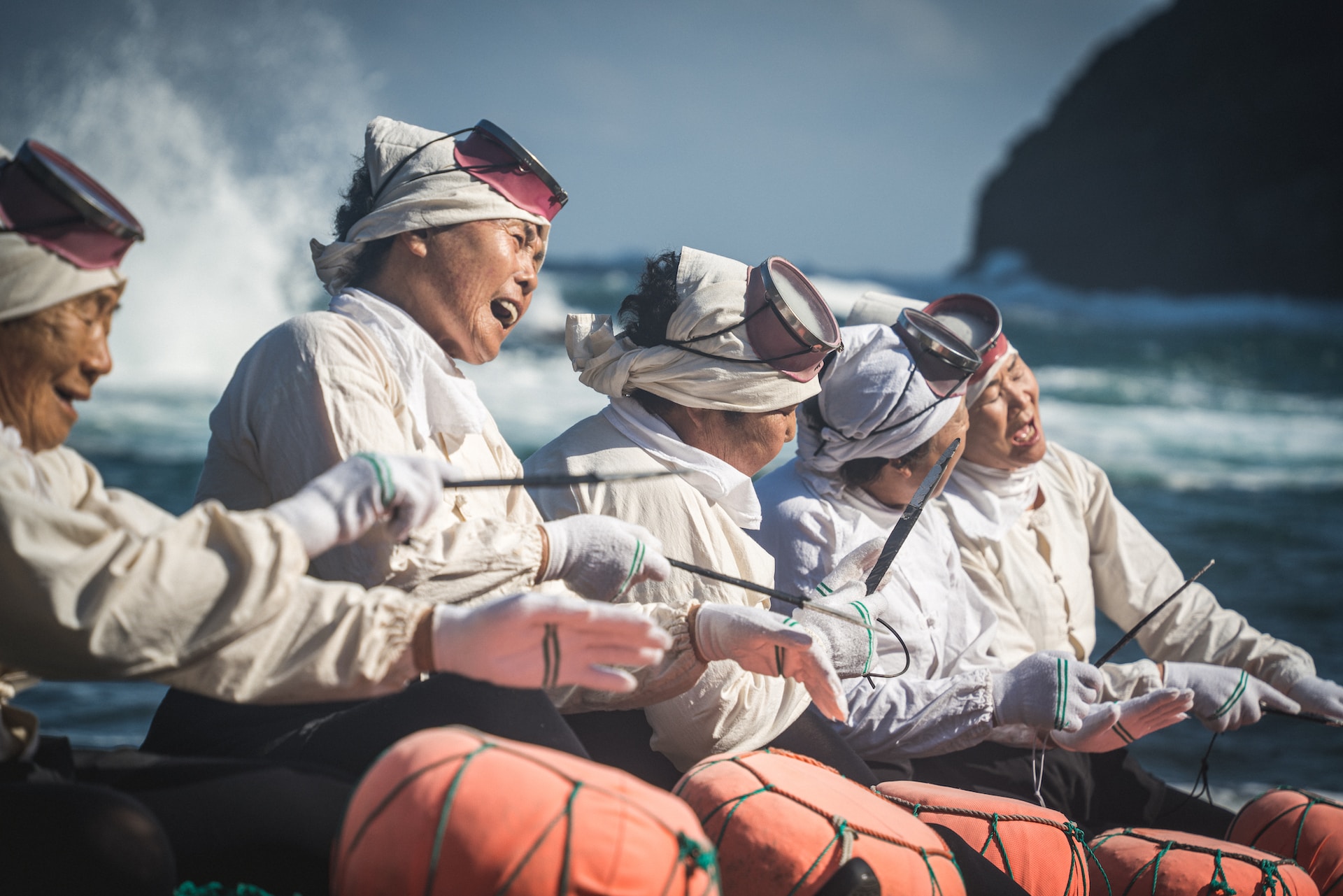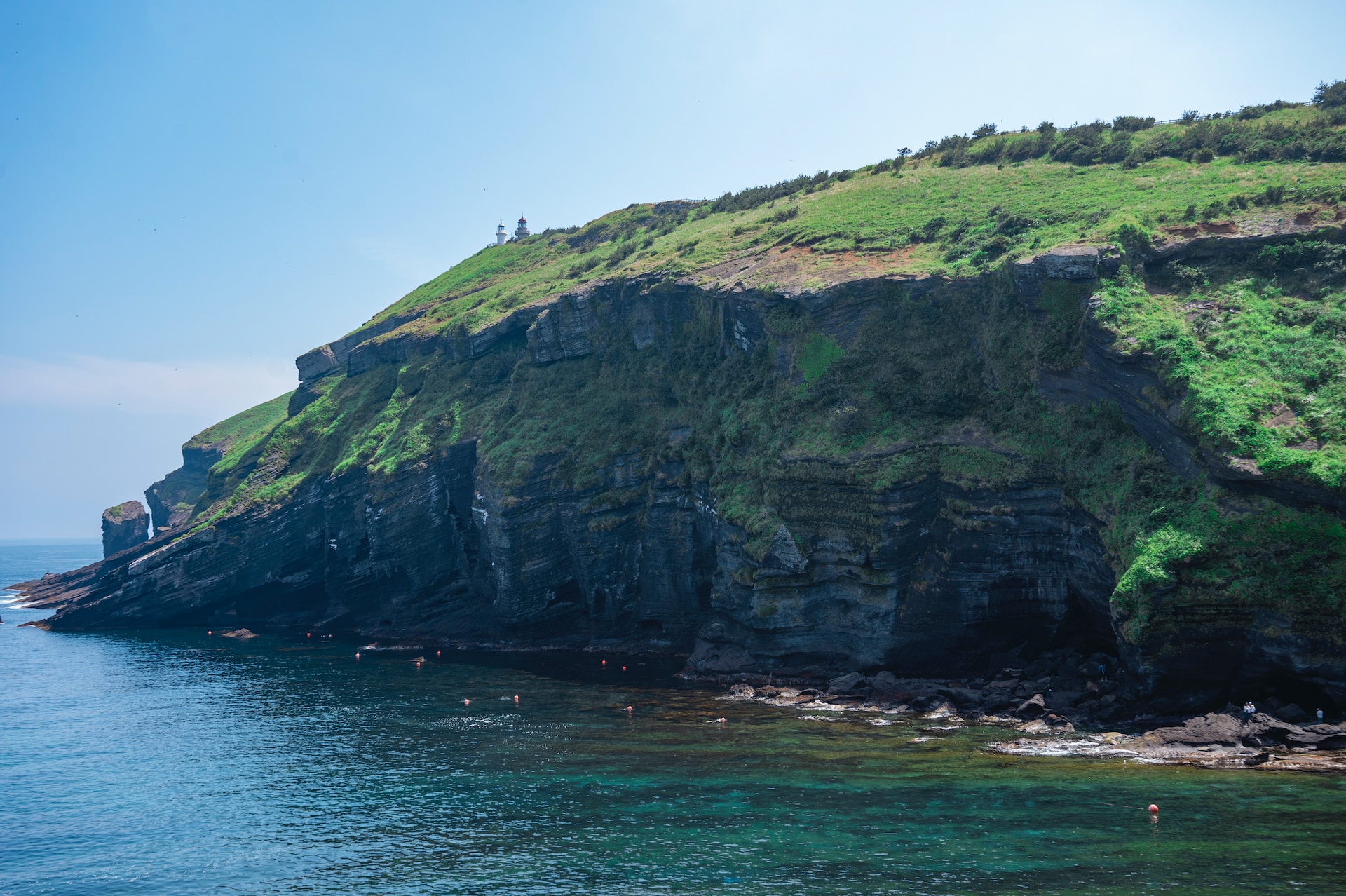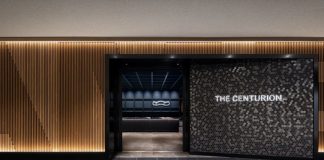If you’re like me, a person who enjoys scenic locations, peaceful ambience, and traditions that goes back centuries, you will love Jeju just like I did!
Jeju has a lot to offer for everybody, from fun filled activities like the Jeju Teseum, and the Aqua Planet Jeju, to the rich history that comes from inhabitants moving onto the island in the 9th century.
Jeju island is also a great destination for a relaxing getaway and basking in the natural wonders.
Flying into Jeju from Seoul is a quick one-hour hop! So, adding this place in your South Korea’s travel itinerary won’t be too bad of an idea!
Here I’ll share five scenic locations that you have to visit when in Jeju!
Seongsan Ilchubong Peak – 성산 일출봉
Seongsan Ilchubong is a tuff cone formed by underwater volcanic activity around 5,000 years ago. Located on the easternmost tip of Jeju Island, the peak has been considered one of the top scenic destinations in Korea. The peak has attracted millions of visitors annually just for its perfect panoramic view.
A quick 800 meter hike up to the 180 meter high peak, you will get a view of Udo Island, Hallasan Mountain, a volcanic landscape, and the ocean, a panoramic of what Jeju has to offer.
View this post on Instagram
The Seongsan Ilchubong Peak is a source of pride for both Jeju residents and Koreans. The name Seongsan Ilchubong translates to “Seongsan Sunrise Peak”, which means that the best thing to do there is to watch the sunrise at the peak! Going before the sunrises will give you an uninterrupted view of the sun rising above the sea, with its light glistening on the waves.
The place opens an hour before the sunrises, and it will be crowded. The pathway is a well-built staircase that brings you to the peak, but it may be dark in the early morning. Bring a flashlight if you need and take your time!
View this post on Instagram
Close to the Seongsan Ilchubong, there is performance that is unique to Jeju. Women in their 60s are seen in diving suits next to the sea. Haenyeo, also known as Jeju Women Divers, will free dive (meaning without an oxygen tank) 10 meters deep to collect shellfishes and other sea lives to sell! These women divers are a cultural importance in Jeju, as these were the women who supported Jeju’s economy in the past.
Born through necessity, in the 17th century, women on Jeju were the sole breadwinners for the family. The men would either go out to sea to fish or have been conscripted in the army, and many will sadly not return. The women were left to oversee taking care of the family. They started diving as seafood was a lucrative business in Jeju. Back then, diving equipment were non-existent, so with the clothes on their back and a knife in their hand, they would dive to collect shellfishes, octopus, and crabs. Minutes at a time, they will repeatedly dive and collect enough sea life to sell at markets to make a living for their children.

Nowadays, the role has evolved from a necessity to a traditional performance, showing the perseverance and tenacity of the woman divers from the past and present.
If you want to find out more, there is also a Haenyeo Museum dedicated to these women divers.
Udo Island – 우도
A brief 15-minute boat ride off the coast of Jeju will take you to Udo Island. An island well-known for its stunning scenery and delicious peanuts! The water surrounds the island, beaches along the shores, and the island formations caused by volcanic activity will take your breath away.

Many visitors come here to rent a bicycle to see the entire island. Bicycles, E-bicycles, and tandem bikes are available for rent on the island, located close to the port and at an affordable price. The circumference of the island is about 17 km, so cycling will take less than a day to finish.
View this post on Instagram
If cycling isn’t your thing, minibikes, and mini cars are available for rent as well, however, an international driving permit is required. They are easily manoeuvrable and easy to drive around, a great way to sightsee without breaking too much of a sweat.
Tourist buses are also available, bringing you around the island to popular spots. However, you are tied to the buses schedule and may feel pressured to leave at certain times.
Relax at the natural beaches along the coasts and eat as much fresh and delicious seafoods at the restaurants. Many cafes and restaurants are built along the path, so take as many breaks as you need and try out the popular items there.
When you visit cafes, you will notice a lot of them selling peanut related food, like peanut ice cream, peanut coffee, or peanut makgeolli. Udo Peanuts are another reason so many come to the island. Udo peanuts are different from normal peanuts, they are higher in quality, have a stronger aroma, and a stronger taste, making them a delicious snack! While on Udo Island, make sure to try out all the peanut items in the cafés!
View this post on Instagram
Please do wear some sunblock, unlike my friends and I, who confidently thought nothing of the sun but ended up with a bad sun burn for the rest of our trip.
Overall, Udo Island is a great place for a day trip to sightsee and relax. A strongly recommended place for couples!
Manjanggul Cave – 만장굴
View this post on Instagram
For visitors, they can access a one kilometer stretch of the cave, making it a fast and simple stroll. The cave is minimally lit, enough for visitors to see where they are going yet keeping the ambience of the cave. Visitors can see a wide variety of lava tubes and cave topographical features like stalactites, stalagmites, and flowstones. Informational boards are found along the cave formations, teaching the science and studies behind each thing.
Walking shoes are recommended for this cave. The pathways are a mix of easy to walk metal walkways and slippery natural cave floors. The natural cave floors tend to not be flat, and water is constantly dripping from the ceiling. This makes the cave hard for individuals who do not have great balance to walk. Elderlies and children should be careful!
You may want to bring a jacket as well! The cave tends to have a drastically different temperature than the outside temperature, staying within the range of 21 degrees Celsius to 11 degrees Celsius no matter the season!
Hallasan – 한라산
Hallasan, Korea’s tallest mountain, is a dormant volcano that peaks at 1,950m above sea level. Due to its high peak, Hallasan’s nickname is “Yeongjusan”, which translates to “mountain high enough to pull the galaxy”.
View this post on Instagram
At the peak, a beautiful lake, named Baengnokdam Lake, stays at the top of Hallasan, surrounded by smaller parasitic cones, called Oreum in Jeju dialect. The ecosystem on the mountain works a little differently from other places. The temperature differences at different altitudes and the rich soil of the mountain have allowed a vertical ecosystem to form. Different altitudes will have completely different species of plants and animals, from subtropical to alpine plants, and tropical and polar animals. This unique view and ecosystem made this mountain a prime hiking destination.
View this post on Instagram
Hallasan has 8 hiking trails, only 2 of which will bring you to the peak. For the best views and experience on Hallasan Mountain, you should go through the Gwaneumsa Trail. It is one of two paths that will take you to the summit, with the best views of the mountain most of the way.
During the Autumn time, the leaves turn a beautiful hue of orange, colouring the mountain vibrantly. In the winter, snow covers the entire mountain, turning the place white!
It is prohibited to stay on the mountain overnight, and hikers are to leave before the sun sets for the night. A reservation is also required 24 hours in advance if you plan on summiting the mountain.
Waterfall Hunting
Waterfalls are another must-see tourist destination in Jeju, having 6 natural waterfalls not too far off from each other. If you rented a car, it is very convenient to visit them all in a day! However, the three recommended later will show enough variety, for you to do other things in that same day!
1. Cheonjeyeon pokpo – 천제연폭포
Cheonjeyeon is the furthest waterfall of the three, so starting here would be best if you want to end closer to the city. Cheonjeyeon, nicknamed “The Pond of God”, is a big waterfall with three sections. The first waterfall falls into a deep and large pond, with a depth of 21 meters. From that pond, it flows and fall two more times before flowing into the sea. In the past, people had believed that the pond had healing properties, with many bathing in the waters daily. However, swimming is strictly prohibited now.
In the area is Seonimgyo Bridge, an iconic bridge that connects between Cheonjeyeon Valley. A beautifully built arch bridge, intentionally crafted with seven nymphs on both sides, representing the Korean legend of the descent of seven beautiful fairies taking a bath in the waters.
View this post on Instagram
2. Cheonjiyeon pokpo – 천지연폭포
View this post on Instagram
Cheonjiyeon falls is close to the center of the south city of Jeju, Seogwipo. When I went, I was sceptical of the place. I had thought “how amazing can a waterfall be if it’s so close to a city?” Turns out, quite amazing.
Cheonjiyeon is given the nickname “Sky connected with land”, and anyone could see why. A twenty-two meter high waterfall falling directly into a large pond. The place felt grand because everything was supersized, and the thunderous crashing from the waterfall made the place feel peaceful.
Getting to the falls was a quick ten minutes from the parking spot, walking beside the flowing river from the waterfall.
Overall, Cheonjiyeon is a great place to soak in waterfalls and to take an amazing picture for social media!
3. Jeongbang pokpo – 정방폭포
View this post on Instagram
In this last location, saving the best for last, Jeongbang Falls is Asia’s only waterfall that falls directly into the ocean. A twenty-three meter high waterfall that crashes into the sea. Jeongbang is arguably the most popular waterfall in Jeju Island, having the best and most reviews on Google!
From the parking lot, it takes around 5 minutes to get to the base of the falls using stairs. Unlike the two other waterfalls, you can walk close to the falls for some great photos! Feel the water crashing near you and be cooled by the mists that the waterfall gives off.
There is an old tale of a man who came looking for an elixir plant on the orders of China’s Emperor. The man, Seobul, was not able to get the elixir plant and was returning to China when he happened to pass Jeongbang Falls. Captivated by the falls, he had engraved “Seobulgwacha” on the cliffs. Although the words have never been found.
View this post on Instagram
After visiting all the waterfalls, you are still within the south town of Jeju, Seogwipo, so it will be incredibly convenient to do the rest of your plans for the day!




